Deck 4: Climate and the World’s Biomes
Question
Question
Question
Question
Question
Question
Question
Question
Question
Question
Question
Question
Question
Question
Question
Question
Question
Question
Question
Question
Question
Question
Question
Question
Question
Question
Question
Question
Question
Question
Question
Question
Question
Question
Question
Question
Question
Question
Question
Question
Question
Question
Question
Question
Question
Question
Question
Question
Question
Question

Unlock Deck
Sign up to unlock the cards in this deck!
Unlock Deck
Unlock Deck
1/50
Play
Full screen (f)
Deck 4: Climate and the World’s Biomes
1
According to Figure 4.11a,the Miconia species of tree,M.prasina fruits during what part of the year? 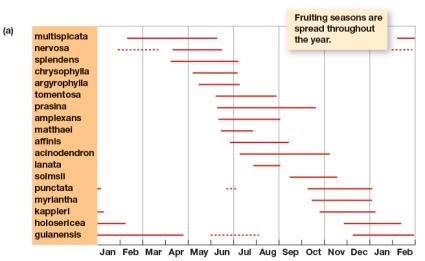
A) December through February
B) July through November
C) June through October
D) March through June

A) December through February
B) July through November
C) June through October
D) March through June
C
2
You are walking in the mountains of southern California and discovery a small stream.One of the things you notice is that,although the surrounding habitat you recently ventured through was rather dry,this habitat is moist and many trees and plants are thriving along the stream where water is plentiful.How would you describe this part of the landscape?
A) These trees and plants are part of an arboreal forest.
B) These trees and plants are part of a riparian zone.
C) These trees and plants are no different from other species adapted to the surrounding arid environment.
D) None of the above.
A) These trees and plants are part of an arboreal forest.
B) These trees and plants are part of a riparian zone.
C) These trees and plants are no different from other species adapted to the surrounding arid environment.
D) None of the above.
B
3
You are flying over a mountain range and notice that the east facing slope of the range looks dry relative to the west facing slope.How could this be explained?
A) The east facing slope is not hit by prevailing winds. As a result descending air on the east facing slope is very dry.
B) The west facing slope is hit by prevailing winds. As a result the east facing slope gets a lot of rain.
C) There is no explanation.
D) The east facing slope is hit by prevailing winds. As a result all moisture is lost on the west facing slope.
A) The east facing slope is not hit by prevailing winds. As a result descending air on the east facing slope is very dry.
B) The west facing slope is hit by prevailing winds. As a result the east facing slope gets a lot of rain.
C) There is no explanation.
D) The east facing slope is hit by prevailing winds. As a result all moisture is lost on the west facing slope.
A
4
What atmospheric effect is responsible for the severe desert conditions found in Death Valley California?
A) Prevailing winds hitting the side of the mountain range where Death Valley is found.
B) Death Valley California is the result of geological processes, not atmospheric.
C) A rain shadow.
D) Anthropogenic-induced climate change.
A) Prevailing winds hitting the side of the mountain range where Death Valley is found.
B) Death Valley California is the result of geological processes, not atmospheric.
C) A rain shadow.
D) Anthropogenic-induced climate change.

Unlock Deck
Unlock for access to all 50 flashcards in this deck.
Unlock Deck
k this deck
5
In Figure 4.11b,which of the following species of plant takes the longest period of time to reach their highest degree of fructification? 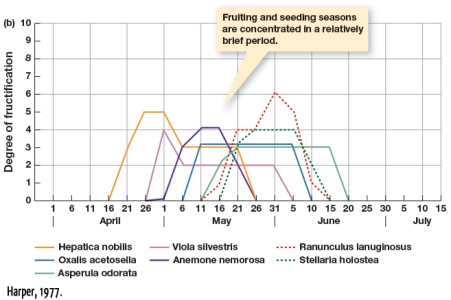
A) Viola silvestris
B) Ranunculus lanuginosus
C) Oxalis acetosella
D) Asperula odorata

A) Viola silvestris
B) Ranunculus lanuginosus
C) Oxalis acetosella
D) Asperula odorata

Unlock Deck
Unlock for access to all 50 flashcards in this deck.
Unlock Deck
k this deck
6
Biodiversity is great at deep sea hot vents.One type of organism you would expect to see at these vents is:
A) A carnivore
B) A chemo-autotroph
C) A species that undergoes photosynthesis
D) A chemo-heterotroph
A) A carnivore
B) A chemo-autotroph
C) A species that undergoes photosynthesis
D) A chemo-heterotroph

Unlock Deck
Unlock for access to all 50 flashcards in this deck.
Unlock Deck
k this deck
7
In deep lakes and ponds,no light reaches the lower layer of the water column.Which of the following would you predict might take place at this bottom layer?
A) There will be an abundance of predators and prey
B) There will be many aerobic bacteria
C) Dissolved oxygen levels will be low
D) Primary productivity will be high
A) There will be an abundance of predators and prey
B) There will be many aerobic bacteria
C) Dissolved oxygen levels will be low
D) Primary productivity will be high

Unlock Deck
Unlock for access to all 50 flashcards in this deck.
Unlock Deck
k this deck
8
Which biome would you expect to have the greatest amount of biodiversity?
A) Desert
B) Boreal forest
C) Tundra
D) Tropical rain forest
A) Desert
B) Boreal forest
C) Tundra
D) Tropical rain forest

Unlock Deck
Unlock for access to all 50 flashcards in this deck.
Unlock Deck
k this deck
9
With regard to community composition,which of the following statements is most accurate?
A) One or a few species ALWAYS dominates in a tropical rain forest biome.
B) One or a few species NEVER dominates in a tropical rain forest biome.
C) Biodiversity is always high in northern coniferous forests.
D) One or a few species ALWAYS dominates in a northern coniferous forest.
A) One or a few species ALWAYS dominates in a tropical rain forest biome.
B) One or a few species NEVER dominates in a tropical rain forest biome.
C) Biodiversity is always high in northern coniferous forests.
D) One or a few species ALWAYS dominates in a northern coniferous forest.

Unlock Deck
Unlock for access to all 50 flashcards in this deck.
Unlock Deck
k this deck
10
Which term describes the number of species found in a particular area?
A) Niche
B) Species richness
C) Habitat density
D) Organismal density
A) Niche
B) Species richness
C) Habitat density
D) Organismal density

Unlock Deck
Unlock for access to all 50 flashcards in this deck.
Unlock Deck
k this deck
11
You are walking through the Atlantic forest and notice that many of the tallest rosewood trees have orchids growing throughout the branches.What type of plant must these orchids be?
A) Parasites
B) Epiphytes
C) Carnivorous
D) Facultative climbers
A) Parasites
B) Epiphytes
C) Carnivorous
D) Facultative climbers

Unlock Deck
Unlock for access to all 50 flashcards in this deck.
Unlock Deck
k this deck
12
According to figure 4.9b,which biome has the greatest amount of precipitation and warmest temperatures? 
A) Boreal forest
B) Desert
C) Mediterranean and chaparral
D) Tropical rain forest

A) Boreal forest
B) Desert
C) Mediterranean and chaparral
D) Tropical rain forest

Unlock Deck
Unlock for access to all 50 flashcards in this deck.
Unlock Deck
k this deck
13
What term describes the total amount of photosynthesis per area for a defined length of time?
A) Primary consumption
B) Chlorophyll capacity
C) Primary production
D) Rate of solar productivity
A) Primary consumption
B) Chlorophyll capacity
C) Primary production
D) Rate of solar productivity

Unlock Deck
Unlock for access to all 50 flashcards in this deck.
Unlock Deck
k this deck
14
Would you find a homogenous assemblage of flora and fauna in a biome?
A) Yes, biomes are not heterogeneous assemblages of plants and animals, and there is little physiochemical variation related to topography and geology within a biome.
B) Yes, biomes are not heterogeneous assemblages of plants and animals, even though there is physiochemical variation related to topography and geology within a biome.
C) No, biomes are heterogeneous assemblages of plants and animals and this is because there is a gradient of physiochemical conditions due to topography and geology.
D) No, biomes are heterogeneous assemblages of plants and animals because conditions at each biome are different.
A) Yes, biomes are not heterogeneous assemblages of plants and animals, and there is little physiochemical variation related to topography and geology within a biome.
B) Yes, biomes are not heterogeneous assemblages of plants and animals, even though there is physiochemical variation related to topography and geology within a biome.
C) No, biomes are heterogeneous assemblages of plants and animals and this is because there is a gradient of physiochemical conditions due to topography and geology.
D) No, biomes are heterogeneous assemblages of plants and animals because conditions at each biome are different.

Unlock Deck
Unlock for access to all 50 flashcards in this deck.
Unlock Deck
k this deck
15
What term defines the land area where all the water draining from it comes to a particular stream or river?
A) Vent
B) Tundra
C) Savannah
D) Watershed
A) Vent
B) Tundra
C) Savannah
D) Watershed

Unlock Deck
Unlock for access to all 50 flashcards in this deck.
Unlock Deck
k this deck
16
You have to wade into a small pond to collect specimens of insects for a research project.You notice that when you wade into the pond,the water is warm on the surface,but as you move into deeper water it is much cooler.What term describes this rapid decrease in water temperature throughout the pond?
A) A thermocline
B) A watershed
C) A biome
D) Eutrophication
A) A thermocline
B) A watershed
C) A biome
D) Eutrophication

Unlock Deck
Unlock for access to all 50 flashcards in this deck.
Unlock Deck
k this deck
17
According to figure 4.9b,which biome has the least amount of precipitation and warmest temperatures? 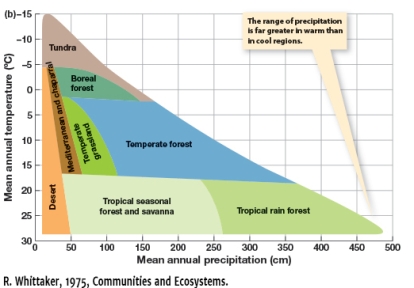
A) Tundra
B) Mediterranean and chaparral
C) Boreal Forest
D) Desert

A) Tundra
B) Mediterranean and chaparral
C) Boreal Forest
D) Desert

Unlock Deck
Unlock for access to all 50 flashcards in this deck.
Unlock Deck
k this deck
18
What type of plant grows on other plants and is often rooted on the damp upper branches?
A) Neophyte
B) Saprophyte
C) Epiphyte
D) Mycorrhizae
A) Neophyte
B) Saprophyte
C) Epiphyte
D) Mycorrhizae

Unlock Deck
Unlock for access to all 50 flashcards in this deck.
Unlock Deck
k this deck
19
What type of organism would you expect to find living at deep sea vents?
A) Carnivores
B) Chemo-autotrophs
C) Grazers
D) Chemo-heterotrophs
A) Carnivores
B) Chemo-autotrophs
C) Grazers
D) Chemo-heterotrophs

Unlock Deck
Unlock for access to all 50 flashcards in this deck.
Unlock Deck
k this deck
20
Which statement is most accurate regarding species richness in a tropical rainforest?
A) Species richness is low relative to a tundra biome.
B) Species richness is moderate compared to all other biomes.
C) Species richness is dramatically greater than all other biomes.
D) Species richness is the same across all biomes.
A) Species richness is low relative to a tundra biome.
B) Species richness is moderate compared to all other biomes.
C) Species richness is dramatically greater than all other biomes.
D) Species richness is the same across all biomes.

Unlock Deck
Unlock for access to all 50 flashcards in this deck.
Unlock Deck
k this deck
21
Westerlies are found:
A) Between 60 and 90 degrees north
B) Between 60 and 90 degrees south
C) Between 30 and 60 degrees north
D) Between 30 and 60 degrees south
A) Between 60 and 90 degrees north
B) Between 60 and 90 degrees south
C) Between 30 and 60 degrees north
D) Between 30 and 60 degrees south

Unlock Deck
Unlock for access to all 50 flashcards in this deck.
Unlock Deck
k this deck
22
Charles Darwin visited much of South America during his voyage on the Beagle.When Darwin was in South America,did surface winds of the Polar,Hadley,and Ferrel cells flow in the same direction as his homeland?
A) Yes, because these cells all flow in the same direction regardless of global position
B) No, because these cells do not flow in the same direction
C) These cells flow in different directions due to the Coriolis effect
D) The Coriolis effect has no significance on these cells
A) Yes, because these cells all flow in the same direction regardless of global position
B) No, because these cells do not flow in the same direction
C) These cells flow in different directions due to the Coriolis effect
D) The Coriolis effect has no significance on these cells

Unlock Deck
Unlock for access to all 50 flashcards in this deck.
Unlock Deck
k this deck
23
What factors are responsible for the formation of a rain shadow between 30 and 60 degree latitudes?
A) Westerlies that carry precipitation.
B) Mountain ranges that force moist air to rise.
C) Changes in temperature correlated with altitude.
D) Rain or snow being released on the west slope-facing side of a mountain and dry, warm air falling on the east slope-facing side of a mountain.
A) Westerlies that carry precipitation.
B) Mountain ranges that force moist air to rise.
C) Changes in temperature correlated with altitude.
D) Rain or snow being released on the west slope-facing side of a mountain and dry, warm air falling on the east slope-facing side of a mountain.

Unlock Deck
Unlock for access to all 50 flashcards in this deck.
Unlock Deck
k this deck
24
Which abiotic processes are responsible for the Ferrel cells?
A) The Coriolis Effect
B) Westerlies
C) Hadley Cells
D) Polar Cells
A) The Coriolis Effect
B) Westerlies
C) Hadley Cells
D) Polar Cells

Unlock Deck
Unlock for access to all 50 flashcards in this deck.
Unlock Deck
k this deck
25
Do you expect similar characteristics to evolve between plant and animal species that are found in regions of the world where environmental conditions are similar?
A) Yes, this is convergent evolution and analogous traits would evolve in these biomes.
B) Yes, but this is not convergent evolution.
C) No, but the traits would be homologous
D) No, this is not convergent evolution, but analogous traits would evolve in these biomes
A) Yes, this is convergent evolution and analogous traits would evolve in these biomes.
B) Yes, but this is not convergent evolution.
C) No, but the traits would be homologous
D) No, this is not convergent evolution, but analogous traits would evolve in these biomes

Unlock Deck
Unlock for access to all 50 flashcards in this deck.
Unlock Deck
k this deck
26
The Ferrel cells are found:
A) Between 30 and 90 degrees north
B) In the northern hemisphere
C) In the southern hemisphere
D) Between 30 and 90 degrees south
A) Between 30 and 90 degrees north
B) In the northern hemisphere
C) In the southern hemisphere
D) Between 30 and 90 degrees south

Unlock Deck
Unlock for access to all 50 flashcards in this deck.
Unlock Deck
k this deck
27
Using Figure 4.12,which animal species would you speculate might be a specialized feeder? 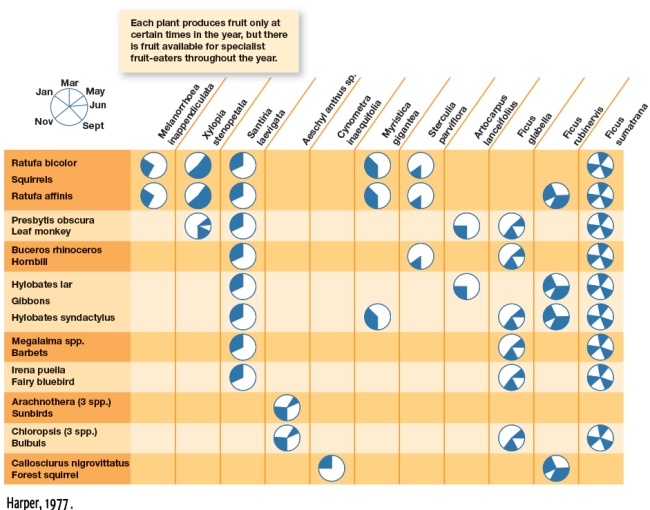
A) Ratufa affinis
B) Hylobates syndactylus
C) Presbytis obscura
D) Arachnothera spp.

A) Ratufa affinis
B) Hylobates syndactylus
C) Presbytis obscura
D) Arachnothera spp.

Unlock Deck
Unlock for access to all 50 flashcards in this deck.
Unlock Deck
k this deck
28
Using Figure 4.12,hypothesize which animal would be the most generalist feeder. 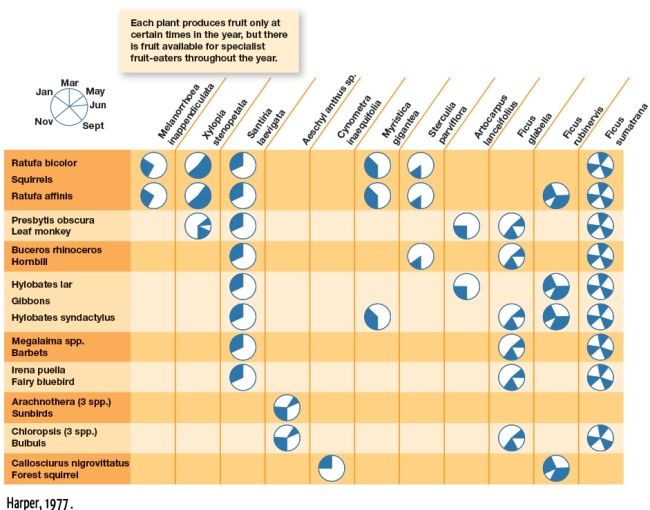
A) Callosciurus nigrovittatus
B) Arachnothera spp.
C) Ratufa affinis
D) None of the above

A) Callosciurus nigrovittatus
B) Arachnothera spp.
C) Ratufa affinis
D) None of the above

Unlock Deck
Unlock for access to all 50 flashcards in this deck.
Unlock Deck
k this deck
29
Large masses of semi-isolated surface water surrounded by a circular current of water moving clockwise would be which of the following?
A) Gyres in the northern hemisphere
B) Vents in the northern hemisphere
C) Gyres in the southern hemisphere
D) Vents in the southern hemisphere
A) Gyres in the northern hemisphere
B) Vents in the northern hemisphere
C) Gyres in the southern hemisphere
D) Vents in the southern hemisphere

Unlock Deck
Unlock for access to all 50 flashcards in this deck.
Unlock Deck
k this deck
30
The change in seasons on Earth is due to:
A) Changes to Earth's distance from the sun during an annual rotation.
B) The Earths rotation.
C) Changes to the tilt of Earth's axis relative to the sun during an annual rotation.
D) Changes in the Earth's core temperature during year, which changes as a result of Earth's distance from the sun.
A) Changes to Earth's distance from the sun during an annual rotation.
B) The Earths rotation.
C) Changes to the tilt of Earth's axis relative to the sun during an annual rotation.
D) Changes in the Earth's core temperature during year, which changes as a result of Earth's distance from the sun.

Unlock Deck
Unlock for access to all 50 flashcards in this deck.
Unlock Deck
k this deck
31
You discover that a species of bacteria is found in all individuals of a species of fish you have studied.It appears that this bacteria lives inside of the fish species,and that it provides this species of fish with some nutrients.What term best describes the role of this bacteria?
A) Parasite
B) Symbiont
C) Detritivore
D) None of the above
A) Parasite
B) Symbiont
C) Detritivore
D) None of the above

Unlock Deck
Unlock for access to all 50 flashcards in this deck.
Unlock Deck
k this deck
32
In Figure 4.12,which species feeds primarily during Malaysia's winter months? 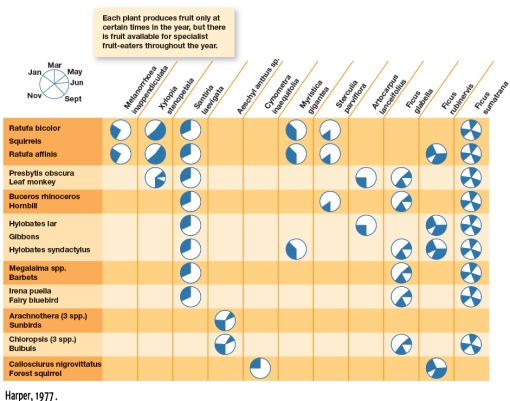
A) Xlopia stenopetala
B) Ficus glabella
C) Ficus sumatrana
D) Myristica gigantea

A) Xlopia stenopetala
B) Ficus glabella
C) Ficus sumatrana
D) Myristica gigantea

Unlock Deck
Unlock for access to all 50 flashcards in this deck.
Unlock Deck
k this deck
33
Because of how sunlight hits the surface of Earth:
A) Heating by sunlight is greater at the North and South Poles
B) Heating by sunlight is greater at the Equator
C) Temperatures are cooler at the Equator
D) Water redistributes heat to temperate and polar regions
A) Heating by sunlight is greater at the North and South Poles
B) Heating by sunlight is greater at the Equator
C) Temperatures are cooler at the Equator
D) Water redistributes heat to temperate and polar regions

Unlock Deck
Unlock for access to all 50 flashcards in this deck.
Unlock Deck
k this deck
34
Which of the following accurately describes the tropical easterlies?
A) They always originate from the east
B) They always originate from the west
C) They occur between 30 degrees north and 30 degrees south
D) They occur between 0 degrees north to 30 degrees north only
A) They always originate from the east
B) They always originate from the west
C) They occur between 30 degrees north and 30 degrees south
D) They occur between 0 degrees north to 30 degrees north only

Unlock Deck
Unlock for access to all 50 flashcards in this deck.
Unlock Deck
k this deck
35
What is one possible explanation of why biodiversity is very high in subtropical gyres?
A) There is a great amount of disturbance that occurs in these sites
B) The low-nutrient status within a gyre has led to specialized adaptations
C) The rich amount of carbon dioxide within a gyre
D) Extensive gene flow between species within gyres and open ocean habitat
A) There is a great amount of disturbance that occurs in these sites
B) The low-nutrient status within a gyre has led to specialized adaptations
C) The rich amount of carbon dioxide within a gyre
D) Extensive gene flow between species within gyres and open ocean habitat

Unlock Deck
Unlock for access to all 50 flashcards in this deck.
Unlock Deck
k this deck
36
According to Figure 4.30,where would expect primary productivity to be greatest? 
A) Subtropical gyres in the northern hemisphere
B) Coastal upwelling sites in the middle of the Pacific Ocean
C) Subtropical gyres found east of South America
D) Coastal upwelling sites along the northwest coast of South America

A) Subtropical gyres in the northern hemisphere
B) Coastal upwelling sites in the middle of the Pacific Ocean
C) Subtropical gyres found east of South America
D) Coastal upwelling sites along the northwest coast of South America

Unlock Deck
Unlock for access to all 50 flashcards in this deck.
Unlock Deck
k this deck
37
Heated air at the equator:
A) Rises and cools
B) Rises and warms
C) Moves towards the equator
D) Moves away from the equator
A) Rises and cools
B) Rises and warms
C) Moves towards the equator
D) Moves away from the equator

Unlock Deck
Unlock for access to all 50 flashcards in this deck.
Unlock Deck
k this deck
38
Which of the following statements are accurate?
A) The rate of primary production is similar in the ocean and on land
B) Total photosynthesis is similar in the ocean and on land
C) Terrestrial biomass is less than marine
D) Marine biomass is less than terrestrial
E) Total biomass is comparable on land and in the ocean
A) The rate of primary production is similar in the ocean and on land
B) Total photosynthesis is similar in the ocean and on land
C) Terrestrial biomass is less than marine
D) Marine biomass is less than terrestrial
E) Total biomass is comparable on land and in the ocean

Unlock Deck
Unlock for access to all 50 flashcards in this deck.
Unlock Deck
k this deck
39
Based on your knowledge of the global climate system,high rates of precipitation occur at certain latitudes because:
A) Air rises and cools there
B) Cool air cannot hold as much moisture as warm air
C) Air gains moisture as it rises and cools
D) Water vapor from cool air condenses
A) Air rises and cools there
B) Cool air cannot hold as much moisture as warm air
C) Air gains moisture as it rises and cools
D) Water vapor from cool air condenses

Unlock Deck
Unlock for access to all 50 flashcards in this deck.
Unlock Deck
k this deck
40
Which of the following are responsible for how heat moves across Earth :
A) Hadley Cells
B) Coreopsis Effect
C) Ferrel Cells
D) Polar Cells
A) Hadley Cells
B) Coreopsis Effect
C) Ferrel Cells
D) Polar Cells

Unlock Deck
Unlock for access to all 50 flashcards in this deck.
Unlock Deck
k this deck
41
Because of _______,the Hadley,Ferrel,and Polar cells push air in different directions in the Northern and Southern Hemisphere.
A) Gravity
B) The Universal Gas Law
C) The Coriolis effect
D) The tilt of Earth on its axis
A) Gravity
B) The Universal Gas Law
C) The Coriolis effect
D) The tilt of Earth on its axis

Unlock Deck
Unlock for access to all 50 flashcards in this deck.
Unlock Deck
k this deck
42
When light from the sun hits Earth _____________,the intensity is greater relative to _______________.
A) At an oblique angle; light that hits at an acute angle
B) At a 90 degree angle; light that hits at an oblique or acute angle
C) At a vertical angle; light at the Equator
D) At a 90 degree angle; light at the Equator
A) At an oblique angle; light that hits at an acute angle
B) At a 90 degree angle; light that hits at an oblique or acute angle
C) At a vertical angle; light at the Equator
D) At a 90 degree angle; light at the Equator

Unlock Deck
Unlock for access to all 50 flashcards in this deck.
Unlock Deck
k this deck
43
Summer in the ___________ biome is in part affected by temperate air masses that result from the Ferrel and Polar cells moving further north.
A) Savanna
B) Boreal forest
C) Desert
D) Tropical rain forest
A) Savanna
B) Boreal forest
C) Desert
D) Tropical rain forest

Unlock Deck
Unlock for access to all 50 flashcards in this deck.
Unlock Deck
k this deck
44
The formation of a savanna biome is largely due to the _______ cell.
A) Hadley
B) Ferrel
C) Polar
A) Hadley
B) Ferrel
C) Polar

Unlock Deck
Unlock for access to all 50 flashcards in this deck.
Unlock Deck
k this deck
45
The ________ cells move heat away from the Equator.
A) Hadley
B) Ferrel
C) Coriolis
D) Polar
A) Hadley
B) Ferrel
C) Coriolis
D) Polar

Unlock Deck
Unlock for access to all 50 flashcards in this deck.
Unlock Deck
k this deck
46
If you were standing in the tropics,which direction would the prevailing winds blow?
A) From the north
B) From the south
C) From the east
D) From the west
A) From the north
B) From the south
C) From the east
D) From the west

Unlock Deck
Unlock for access to all 50 flashcards in this deck.
Unlock Deck
k this deck
47
The spinning of the Earth affects the motion of air masses.This effect is referred to as the ________________.
A) Coriolis Effect
B) Hadley Effect
C) Polar Cells
D) Ferrel Effect
A) Coriolis Effect
B) Hadley Effect
C) Polar Cells
D) Ferrel Effect

Unlock Deck
Unlock for access to all 50 flashcards in this deck.
Unlock Deck
k this deck
48
You notice a stream that has extremely clear water.Which of the following potential observations might explain the clarity of the stream?
A) There appears to be a large amount of fertilizer runoff from a nearby habitat
B) There is a large canopy of trees that block much of the sunlight
C) The water temperature is very high and dissolved oxygen levels very high
D) You test the water and determine there is a high concentration of nitrogenous compounds.
A) There appears to be a large amount of fertilizer runoff from a nearby habitat
B) There is a large canopy of trees that block much of the sunlight
C) The water temperature is very high and dissolved oxygen levels very high
D) You test the water and determine there is a high concentration of nitrogenous compounds.

Unlock Deck
Unlock for access to all 50 flashcards in this deck.
Unlock Deck
k this deck
49
If you were standing in New York City,prevailing winds would blow from which direction?
A) East
B) West
C) North
D) South
A) East
B) West
C) North
D) South

Unlock Deck
Unlock for access to all 50 flashcards in this deck.
Unlock Deck
k this deck
50
Which direction do prevailing surface winds blow in temperate latitudes?
A) East
B) West
C) North
D) South
A) East
B) West
C) North
D) South

Unlock Deck
Unlock for access to all 50 flashcards in this deck.
Unlock Deck
k this deck



